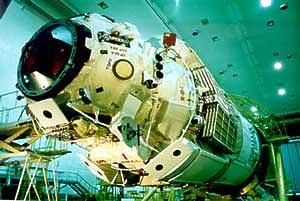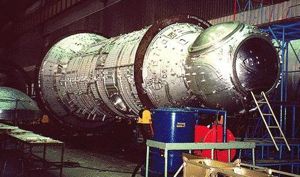
Home - Search - Browse - Alphabetic Index: 0- 1- 2- 3- 4- 5- 6- 7- 8- 9
A- B- C- D- E- F- G- H- I- J- K- L- M- N- O- P- Q- R- S- T- U- V- W- X- Y- Z
ISS Zarya
 Zarya FGB Credit: Energia |
AKA: 77KM;Alpha-FGB;FGB;Zarya;CM. Status: Operational 1998. First Launch: 1998-11-20. Last Launch: 1998-11-20. Number: 1 . Gross mass: 20,000 kg (44,000 lb). Unfuelled mass: 8,000 kg (17,600 lb).
The Russian Zarya FGB space tug was the cornerstone of the new International Space Station since it acted as an adapter between the US and Russian-built ISS segments and also provided some propulsion and propellant storage capabilities. It was closely based on the older Russian TKS spacecraft design that was intended as a ferry for the Almaz military station. The United States paid $220 million for the FGB (vs. $450 million for Lockheed's rejected 'Bus-1' option) and Khrunichev successfully completed the project on schedule and within budget. However, the launch had to be delayed by 17 months to November 1998 because the Russians were unable to complete their own ISS Zvezda service module on time.
The Russian-built propulsion module that was the first element of the International Space Station. Launched by a three-stage Proton rocket, the Zarya control module, also known by the technical term Functional Cargo Block and the Russian acronym FGB provided the station's initial propulsion and power. The 20,000 kg pressurized module was launched on Nov. 20 1998 from the Baikonur Cosmodrome, Kazakhstan.
The module was named Zarya, meaning "sunrise", in tribute to the new beginning in space that would be ushered in by the its launch as the first component of the International Space Station (and to finally use the name the engineers wanted to call the first Russian space station, Salyut 1, 28 years earlier). Its launch marked the beginning of an international venture of unprecedented scale.
Less than two weeks after Zarya reached orbit, the Space Shuttle Endeavour rendezvoused with it and attached the U.S.-built Unity connecting module. Zarya was to provide orientation control, communications and electrical power attached to Unity for several months before the launch of the third component, a Russian-provided crew living quarters and early station core known as the Service Module. The Service Module would enhance or replace many functions of the Zarya. Later in the station's assembly sequence, the Zarya module was to be used primarily for its storage capacity and external fuel tanks.
Zarya's solar arrays and six nickel-cadmium batteries provided an average of 3 kilowatts of electrical power. Each of the two solar arrays was 11 m long and 3 m wide. Using the Russian Kurs system, the Zarya would perform an automated and remotely piloted rendezvous and docking with the Service Module in orbit. Its docking ports would accommodate Russian Soyuz piloted spacecraft and unpiloted Progress resupply spacecraft. The module was modified to allow it to be refueled by a Progress vehicle docked to its down-facing port if necessary. The module's 16 fuel tanks held more than 6 metric tons of propellant. The attitude control system for the module included 24 large steering jets and 12 small steering jets. Two large engines were available for reboosting the spacecraft and making major orbital changes.
After reaching the initial elliptical orbit and separating from the Proton's third stage, a set of pre-programmed commands automatically activated the module's systems and deployed the solar arrays and communications antennae. On ensuing days after several operational tests, the module was commanded to fire its engines and circularize its orbit at an altitude of about 390 km, the orbit at which Endeavour would rendezvous and capture the spacecraft using the Shuttle's robotic arm.
The U.S.-funded and Russian-built Zarya was a U.S. component of the station although it was built by the Khrunichev State Research and Production Space Centre (KhSC) in Moscow under a subcontract to The Boeing Co. for NASA. It was shipped to the Baikonur Cosmodrome, Kazakhstan, launch site to begin launch preparations in January 1998.
More at: ISS Zarya.
Family: Space station, Space station orbit, USA - Space Stations. Country: Russia. Engines: KRD-442. Spacecraft: ISS. Launch Vehicles: Proton, Proton-K. Launch Sites: Baikonur, Baikonur LC81/23. Agency: NASA, Chelomei bureau. Bibliography: 2, 3512, 7, 8.
 | FGB in shop Russian propulsion module to be first element of International Space Station. Credit: NASA |
 | Zarya Credit: Manufacturer Image |
1998 January - .
- Zarya FGB delivered to Baikonur - . Nation: Russia. Spacecraft: ISS, ISS Zarya. The U.S.-funded and Russian-built Zarya was a U.S. component of the International Space Station..
1998 November 20 - . 06:40 GMT - . Launch Site: Baikonur. Launch Complex: Baikonur LC81/23. LV Family: Proton. Launch Vehicle: Proton-K.
- Zarya - .
Payload: FGB 77KM s/n 175-01. Mass: 20,000 kg (44,000 lb). Nation: USA.
Agency: NASA.
Manufacturer: Chelomei bureau.
Program: ISS.
Class: Manned.
Type: Manned space station. Spacecraft Bus: ISS.
Spacecraft: ISS Zarya.
USAF Sat Cat: 25544 . COSPAR: 1998-067A. Apogee: 403 km (250 mi). Perigee: 374 km (232 mi). Inclination: 51.60 deg. Period: 92.30 min.
This was the first launch in the assembly of the International Space Station. The Zarya FGB was funded by NASA and built by Khrunichev in Moscow under subcontract from Boeing for NASA. Its design from the TKS military station resupply spacecraft of the 1970's and the later 77KS Mir modules. Zarya included a multiple docking adapter, a pressurised cabin section, and a propulsion/instrument section with a rear docking port. Initial orbit was 176 lm x 343 km x 51.6 degrees. By November 25 it had manoeuvred to a 383 km x 396 km x 51.7 degree orbit, awaiting the launch of Shuttle mission STS-88 which docked the Unity node to it.
Back to top of page
Home - Search - Browse - Alphabetic Index: 0- 1- 2- 3- 4- 5- 6- 7- 8- 9
A- B- C- D- E- F- G- H- I- J- K- L- M- N- O- P- Q- R- S- T- U- V- W- X- Y- Z
© 1997-2019 Mark Wade - Contact
© / Conditions for Use